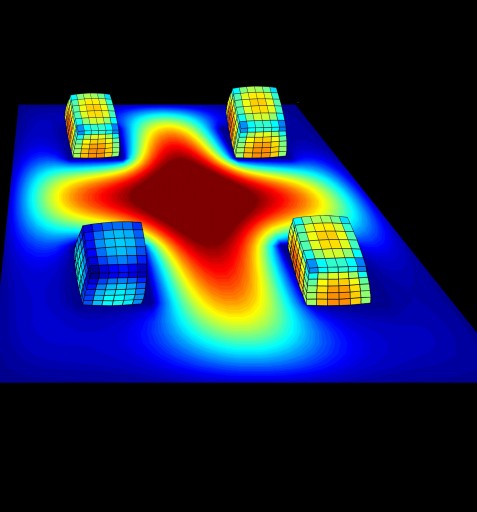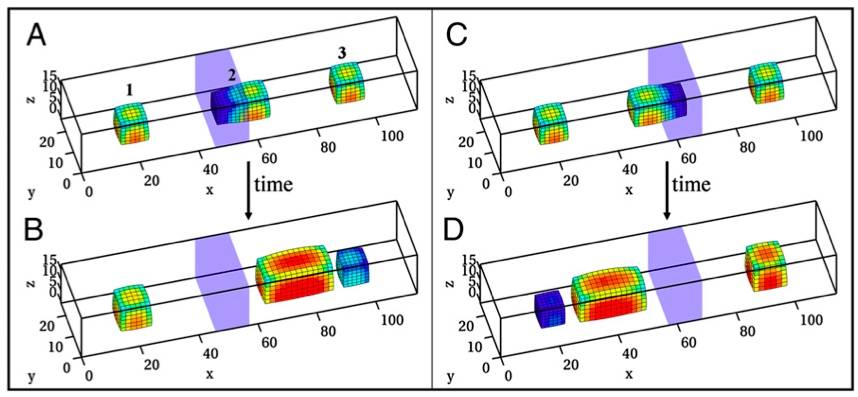Synthetic oscillating gel ‘acts alive’
January 15, 2013

Oscillating gel pieces will move back together after being sliced (credit: Pratyush Dayal et al./University of Pittsburgh)
Synthetic self-moving gels can “act alive” and mimic primitive biological communication, University of Pittsburgh researchers have found.
The synthetic system can reconfigure itself through a combination of chemical communication and interaction with light.
“This is the closest system to the ultimate self- recombining material, which can be divided into separated parts and the parts move autonomously to assemble into a structure resembling the original, uncut sample,” the researchers say in a Proceedings of the National Academy of Sciences paper.
“We also show that the gels’ coordinated motion can be controlled by light, allowing us to achieve selective self-aggregation and control over the shape of the gel aggregates.”
Anna Balazs, principal investigator of the study and Distinguished Professor of Chemical and Petroleum Engineering in Pitt’s Swanson School of Engineering, has long studied the properties of the Belousov-Zhabotinsky (BZ) gel, a material first fabricated in the late 1990s and shown to pulsate in the absence of any external stimuli.
In a previous study, the Pitt team noticed that long pieces of gel attached to a surface by one end “bent” toward one another, almost as if they were trying to communicate by sending signals. This hint that “chatter” might be taking place led the team to detach the fixed ends of the gels and allow them to move freely.

Regulating self-aggregation of gels via light; gel 2 can be controllably shuttled to the left or right. (A) Initial distance of gels 1 and 3 from the y-boundary: 15 units. Distance of gels from the fluid x-boundaries: 7.5 units. Light is applied to left side of gel 2. (B) Late time behavior of system in A. (C) Same initial position as in A. Light is applied to the right side of gel 2. (D) Late time behavior of system in C. (Credit: Pratyush Dayal et al./PNAS)
Balazs and her team developed a 3-D gel model to test the effects of the chemical signaling and light on the material. They found that when the gel pieces were moved far apart, they would automatically come back together, exhibiting autochemotaxis — the ability to both emit and sense a chemical, and move in response to that signal.
“This study demonstrates the ability of a synthetic material to actually ‘talk to itself’ and follow out a given action or command, similar to such biological species as amoeba and termites,” said Balazs.
“Imagine a LEGO set that could by itself unsnap its parts and then put itself back together again in different shapes but also allow you to control those shapes through chemical reaction and light.”
“Species ranging from single-cell organisms to social insects can undergo autochemotaxis, where the entities move toward a chemo-attractant that they themselves emit,” the authors write.
“This mode of signaling allows the organisms to form large-scale structures, with amoebas and Escherichia coli self-organizing into extensive multicellular clusters and termites constructing macroscopic mounds.”
The work was partially supported by the National Science Foundation, Army Research Office, and Air Force Office of Scientific Research.